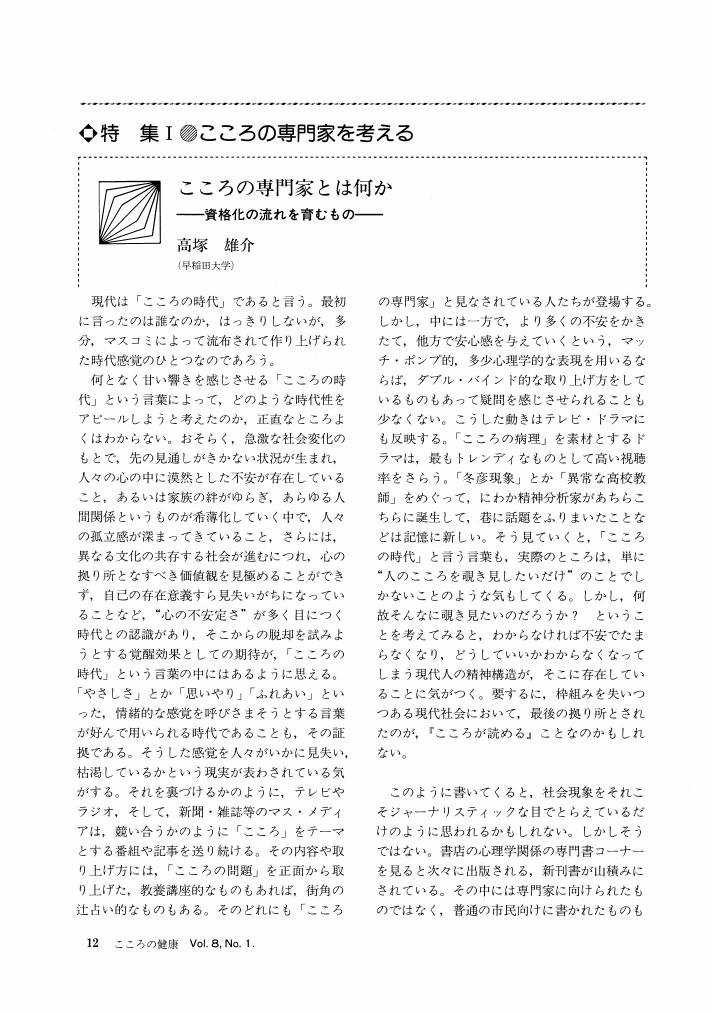2 0 0 0 OA こころの専門家とは何か
- 著者
- 高塚 雄介
- 出版者
- 日本精神衛生学会
- 雑誌
- こころの健康 (ISSN:09126945)
- 巻号頁・発行日
- vol.8, no.1, pp.12-16, 1993-06-10 (Released:2011-03-02)
1 0 0 0 カウンセリングと疲労 (特集 感情労働と疲労)
- 著者
- 高塚 雄介
- 出版者
- 労働科学研究所出版部
- 雑誌
- 労働の科学 (ISSN:00357774)
- 巻号頁・発行日
- vol.57, no.8, pp.473-476, 2002-08
- 被引用文献数
- 1
1 0 0 0 OA 震災ストレス~PTSD化を防ぐには
- 著者
- 高塚 雄介
- 出版者
- 公益財団法人 パブリックヘルスリサーチセンター
- 雑誌
- ストレス科学研究 (ISSN:13419986)
- 巻号頁・発行日
- vol.27, pp.1-4, 2012 (Released:2012-11-21)
Great disaster brings a serious wound in the mental of the person and is known to give a obstacle in life. However, the influence to give a mental is big and is different in a case brought artificially when a disaster is brought by nature. Most of wounds of a mental brought by natural disaster are more likely to be healed with progress of thetime, but, as for the artificial disaster, anger and hatred are easy to be amplified with progress of the time. It is thought that victims of the East Japan great earthquake disaster of the last year are different from an earthquake in the person who met with the thing that the atural disaster called the tsunami and the element of the artificial disaster called the collapse of the nuclear power plant are high in the next progress. It is thought that it is necessary to consider what kind of correspondence method should be taken for the condition of stress that is dripped even if both mingle minutely.
1 0 0 0 OA 甘えの文化とひきもこり
- 著者
- 高塚 雄介
- 出版者
- 日本精神衛生学会
- 雑誌
- こころの健康 (ISSN:09126945)
- 巻号頁・発行日
- vol.20, no.1, pp.13-24, 2005-06-10 (Released:2011-03-02)
1 0 0 0 OA ひきこもりおよびひきこもり親和性を規定する要因の検討
- 著者
- 渡部 麻美 松井 豊 高塚 雄介
- 出版者
- 公益社団法人 日本心理学会
- 雑誌
- 心理学研究 (ISSN:00215236)
- 巻号頁・発行日
- vol.81, no.5, pp.478-484, 2010 (Released:2011-04-20)
- 参考文献数
- 13
- 被引用文献数
- 6 8
This study examined the determinants of social withdrawal using data from a survey by the Tokyo Metropolitan Government Office for Youth Affairs and Public Safety (2008). In addition, this study identified young people who showed an affinity for social withdrawal although they were not in a state of withdrawal, and examined the determinants of an affinity for social withdrawal. The results of stepwise discriminant analysis showed that factors such as social phobia, depression, violence, and emotional bonds with family differentiated between the general youth group and the social withdrawal group and the “affinity group”. Social phobia, violence, and refusal to be interfered in self-decision making differentiated between the social withdrawal group and the “affinity group”. This study shows that an “affinity group” should be cared as well as an actual withdrawal group.
1 0 0 0 ひきこもりへの理解と対応 (特集 ニート--転換する現代文明)
1 0 0 0 心理学から見た「居」場所
- 著者
- 高塚雄介
- 出版者
- 学陽書房
- 雑誌
- 子ども 若者の居場所の構想
- 巻号頁・発行日
- 2001
- 被引用文献数
- 1
- 著者
- 高塚 雄介
- 出版者
- 日本精神衛生会
- 雑誌
- 心と社会 (ISSN:00232807)
- 巻号頁・発行日
- vol.39, no.2, pp.110-118, 2008

